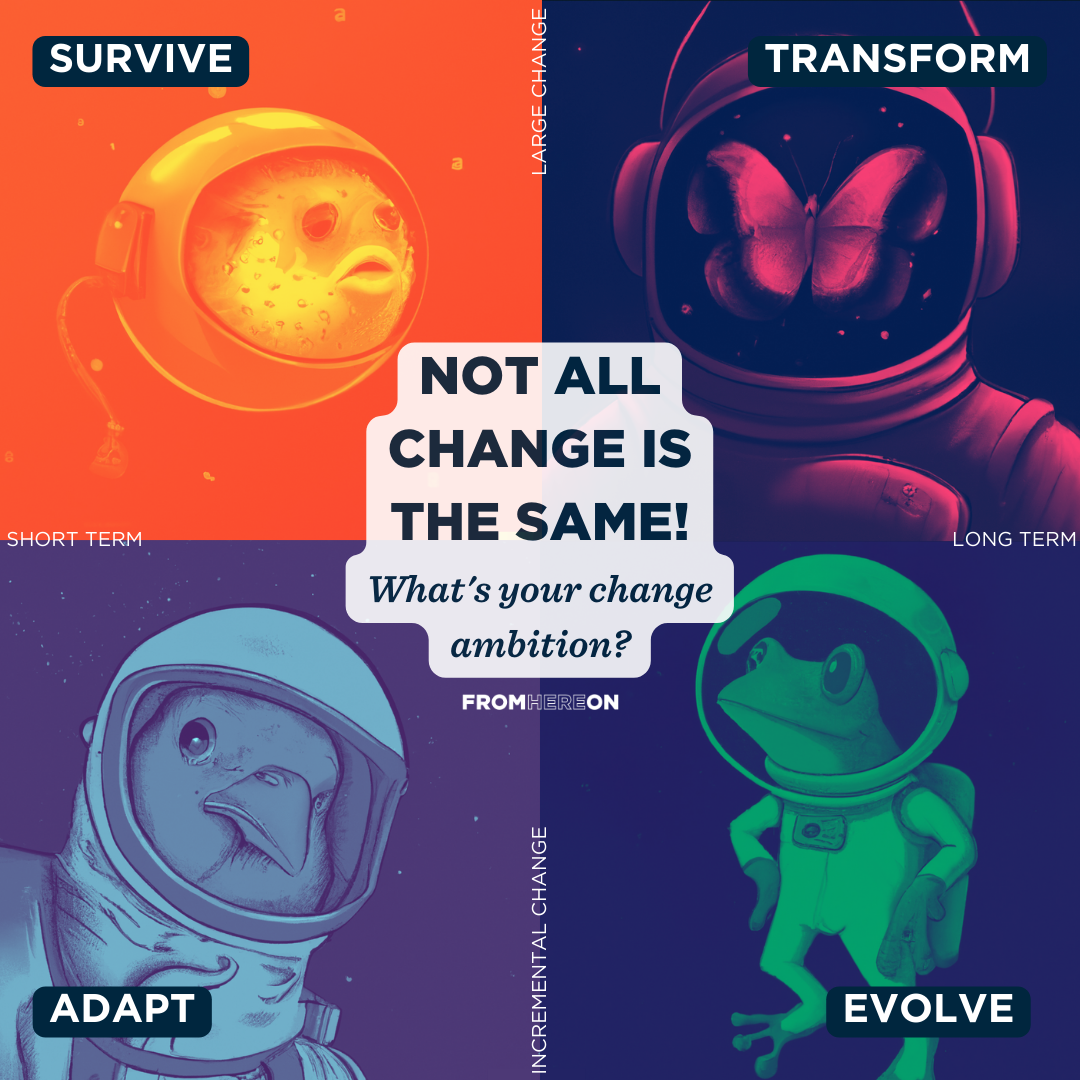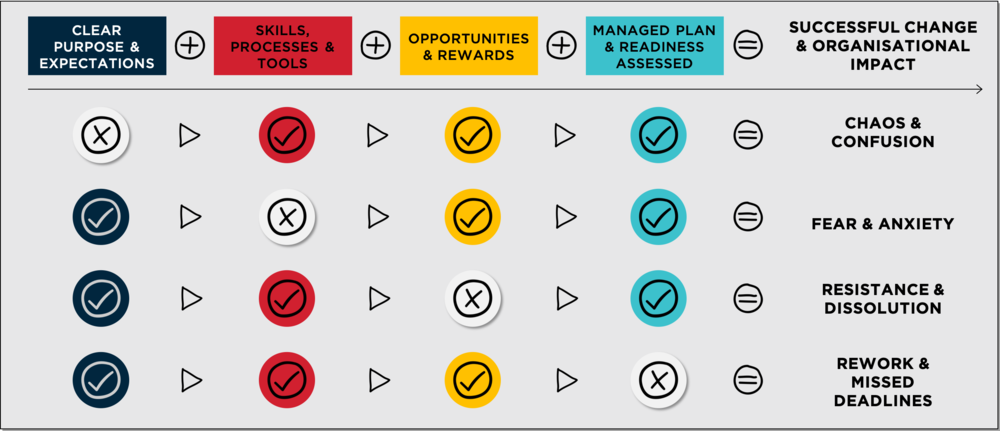Change fatigue - falling asleep at the wheel
CHANGE FATIGUE IS DANGEROUS. HERE’S HOW TO NOT FALL ASLEEP AT THE WHEEL
We all should welcome the opportunity to be involved in and help shape the strategic direction of our organisation, to reimagine what’s possible, to improve the lives of our customers and colleagues. Most people inherently take pride in their work and care about the success of the companies they work for. So why, when opportunities for change arise, ‘transformation programmes’, are they often met with resistance, scepticism, fear, and a feeling of ‘here we go again?’
Transformation programmes can feel a bit like political campaigns. Visionary leaders promise a better world to gain our trust (and vote or buy-in), yet often those promises are replaced with excuses. We are left feeling tired, deflated, and kind of betrayed.
It’s a lot to take in if there is a transformation programme launching every other week. We don’t get enough time to adjust to the new normal, and it can be overwhelming. This condition can be thought of as change fatigue, and, pun intended, we are tired of it.
It’s time to learn from our experiences and take a different approach to change. Organisational leaders, the ball is firmly in your court.
SO, WHAT CAN WE ALL DO DIFFERENTLY?
We have identified seven contributors to change fatigue, exploring how it feels for employees and how best to avoid triggers.
1) WE’VE SEEN IT ALL BEFORE ... AND IT WASN’T ALL THAT.
Most of us have been part of a transformation programme before. The launch of a new one will likely initially be met with some excitement. However, it almost always evokes some anxiety as well. Think budget cuts, increased pressure, the departure of colleagues and friends, etc.
Before announcing yet another exciting transformation, delve into your people’s past experiences. It would be best to do this in-person rather by a mass survey. After hearing from your people, adapt your plans accordingly. A mature leader will gain respect by listening, being open about past experiences, and clearly articulating what’s going to be different this time.
2) NOT EVERYTHING IS A ‘TRANSFORMATION’— AND THAT’S A GOOD THING.
Transformation by definition is about large-scale and long-term change. A butterfly is a great example of this.
The term ‘transformation’ sits in buzzword territory, no longer packing a punch. How the term is perceived by staff is important. It can imply that a holistic, disruptive change is required. Sometimes, this might leave an impression that changes will be bigger or more drastic than intended by upper management.
Most change projects are about adapting to market conditions or evolving current processes as a means of continuous improvement. These are not necessarily ‘transformations’; they just enable business agility. We should promote them as such and take pride in the fact that wholesale transformation is usually not necessary.
3) BE CLEAR ABOUT THE WHY, AND ALLOW YOUR PEOPLE TIME TO FOLLOW.
Never underestimate the importance of aligning your organisation around a clear and compelling vision for the future. The sooner we can understand why something is happening, the sooner we can get on board with the change and actively contribute towards it.
We have seen two common mistakes that leaders make regarding vision:
a lack of appreciation of how long the rest of the organisation will take to understand and accept the vision (remember, they weren’t invited to your week-long leadership off-site)
assuming that the leadership team is actually aligned. Ask yourself: Have we all interpreted the outcome of that off-site in the same way, and are we all equally invested?
If the leadership are speaking with a unified voice, then people are usually much more inclined to buy-in and follow.
4) ENOUGH WITH THE LEADERSHIP— GIVE THE PEOPLE A VOICE.
There is no question that executive endorsement is invaluable. But for many, true buy-in happens when influenced by a peer rather than a leader.
People experiencing change fatigue often feel their leaders don’t understand what it feels like to experience the change on the front line. Therefore, repetitive communication from the top about how well things are going can be interpreted as inauthentic.
Each layer of an organisation has a valuable voice throughout a change programme. In particular, it is the first followers who will be generating the change momentum.
If you really want to do something different, try appointing a change champion within your leadership team, and an executive working on the front line. The more we break down hierarchy and politics, the more commonality we have, just a group of people all experiencing the unknown together.
5) BE AS TRANSPARENT AS POSSIBLE
A common and irritating trend is when a ‘transformation programme’ is really just a cost-saving initiative disguised with a sexy veneer. In hiding reality, it doesn’t give employees enough credit: ‘Yes, I may not be an executive, but do you think I can’t comprehend that we need to cut costs and increase margins?’
Leadership can fear that being open about cost-cutting will spread anxiety throughout the organisation. However, hiding critical information often breeds even more anxiety. ‘Why were you not able to tell me that? What else are you not telling me?’
Value your people who care about the company as well. Explain the why instead of hiding the what, and it will be much easier for them to follow.
6) THE SYSTEM NEEDS TO CHANGE, TOO.
One of the biggest sources of change resistance is the inability to provide a compelling answer to ‘What’s in it for me?’
This question can be answered in two ways. First, look at the end state, defining what the future will look like and why it will be better for those impacted. Second, explain why the current way of doing things can’t continue. If you can demonstrate both of these, the majority are likely to be on board.
A more complex question centres around creating the movement; this is where many programmes slip up. They want their people to get engaged, but the system and roles themselves are not consistent with that goal (for example, not aligned with employee performance goals). This is a real shame, as the opportunity for someone to join a change programme can be fantastic, providing a welcomed variation in responsibilities, exposure to senior leadership, and opportunities to learn new skills.
If you want to start a movement, you need to design a system that not only allows your people to join, but actively encourages them to do it.
7) INVEST IN CHANGE, NOT JUST CHANGE MANAGEMENT.
Change management is a fairly well-understood discipline. So why do the majority of transformation programmes keep failing to prepare and support their organisations to make change?
IBM suggests that at least 11% of a transformation budget should be invested in change for it to be successful. The problem is that organisations tend to hire a change manager as the ‘package solution’, and thus tick that box. This is an immature view. Much more is needed than just change management—specifically, change leadership.
The role of the change manager (leader) is not simply to develop the best strategies and plans to implement the change. He/she must also lead and support the organisation through it by understanding their capacity to accept change and the impact it will cause. It is the role of every manager and every member of a transformation team to promote a culture of supporting people through the change journey.
If you want to prevent change fatigue in your organisation, deliver something tangible.
To recap, here are five quick tips:
Make your employees change champions.
Small changes done well are more effective than an overly ambitious plan. Don’t ‘boil the ocean’.
Be wary of language. Think about the type of change you are undertaking and define with purpose. Are you genuinely transforming?
Make sure your leadership team is fully invested, aligned and committed.
Don’t hire the same consultancy partner and expect different results. Try partnering with smaller firms that can bring creative approaches (like FromHereOn).
Take regular pulse checks of engagement, this can be done with check-ins or, try something different like asking employees to place coloured marbles in a glass jar to register sentiment.
Ensure HR business is involved from the start. For transformation to be a success, employee performance goals need to align.
FROMHEREON, WE CAN HELP MANAGE CHANGE FATIGUE IN YOUR ORGANISATION
As uncomfortable as change is, the necessity of change is never going away. Business survival depends on the speed with which leaders and team members can commit to, accept, and get behind change. It is never easy, but with the right mindset, plan, and people, it can be exciting, innovative, and breathe new life into any organisation.
We’ve been on our own change journey. We evolved our service offering and approach from traditional enterprise architecture to human-centred business design to understand the people side of change. When supporting transformation programmes, we orient on value, outcomes and meaningful experiences for people. We have developed a unique and effective perspective on how to make change happen.



